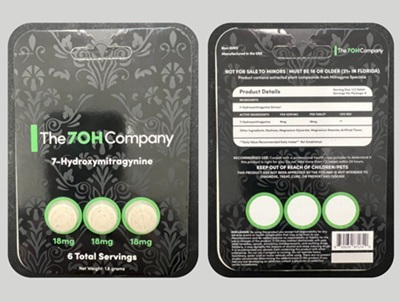
Photo credit: CFSRE
In recent years, legal smoke shops have seen a surge in the sale of Kratom products. Marketed as “7-Hydroxymitragynine” products, these include chewable tablets, concentrates, extracts, edible materials and even beverages.
Kratom comes from the leaves of Mitragyna speciosa, a tropical evergreen tree of the Rubiaceae family (coffee family) native to Southeast Asia. It has been used in herbal medicine since at least the 19th century.
In natural Kratom leaves, the alkaloid 7-Hydroxymitragynine is only present in extremely small amounts—around 0.01% to 0.04% of total alkaloid content. In fact, extracting 7-Hydroxymitragynine in high concentrations directly from natural Kratom leaves is not feasible due to the natural yield being so low. However, some of the commercial “7-Hydroxymitragynine” products have been found to contain highly elevated 7-Hydroxymitragynine contents.
“It is unclear how Kratom is being processed in these settings to make 7-Hydroxymitragynine-dominant products,” said the Center for Forensic Science Research and Education (CFSRE) in their recently published evaluation of these commercial products.
Chemical background
Mitragynine is a pharmacologically complex drug, exhibiting stimulant-like effects at low doses and sedative effects at higher doses. It exhibits opioid-like effects through its partial agonism of opioid receptors and interacts with adrenergic and serotonergic receptors.
Mitragynine use is typically associated with antinociceptive, anti-inflammatory, anti-depressant, and anxiolytic effects. It is metabolized to 7-Hydroxymitragynine and further to mitragynine pseudoindoxyl; however, the in vivo presence of these alkaloids is often unclear as both can arise from Kratom itself.
7-Hydroxymitragynine and mitragynine pseudoindoxyl are reportedly more potent than mitragynine, on the order of 10x and 100x, respectively. Testing for these two alkaloids is extremely limited based on published reports, and—of note—mitragynine and 7-hydroxy mitragynine exhibit poor stability, especially in biological matrix.
Evaluation
Due to increased sale and availability of Kratom products marketed as “7 -Hydroxymitragynine,” CFSRE’s laboratory collected samples for comprehensive forensic drug analysis. The samples included one powder and several pressed pills, some of which were purchased legally from a local smoke shop.
Data processing included targeted, concurrent spectral identification of mitragynine, 7-hydroxymitragynine, and mitragynine pseudoindoxyl, and suspect screening was performed for mitragynine isomers and additional Kratom alkaloids. 7-Hydroxymitragynine and mitragynine pseudoindoxyl were indistinguishable by GC-MS; thus, analysis via LC-QTOF-MS was required for identification and differentiation.
According to CFSRE’s results, all products analyzed contained 7-hydroxymitragynine—most as the primary component. Additionally, all products contained at least detectable amounts of mitragynine and mitragynine pseudoindoxyl, as well as additional other Kratom alkaloids.
“The objective of this report is to detail our findings from forensic testing of ‘7-Hydroxy Mitragynine’ marketed commercial products for notification to public health, public safety, clinicians, medical examiners, coroners, forensic laboratories, and other related communities regarding this emerging topic of concern,” CFSRE’s wrote in its public alert.
In 2016, the U.S. Drug Enforcement Administration (DEA) issued a notice of intent to schedule mitragynine and 7-hydroxy mitragynine; however, the DEA ultimately withdrew their proposed rule, leaving these Kratom alkaloids—which are scheduled in other countries—unscheduled and uncontrolled in the U.S.
All data courtesy of CFSRE